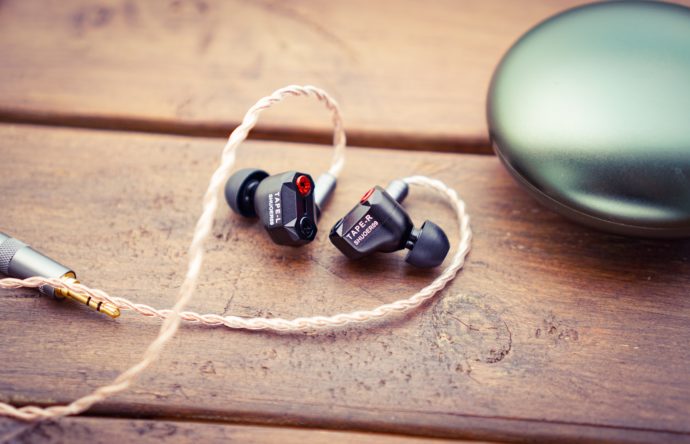Low-voltage Electrostatic Driver:
The most interesting part about Tape – the electrostatic driver – is also somewhat of a mystery in terms of how it’s actually implemented. Whereas true electrostatic earphones like the Shure KSE1500 require a dedicated energiser to drive the transducers, the Tape is able to be powered from any standard source. There’s also very little by way of comprehensive technical information describing the driver set-up and technology. It’s described on Linsoul as an ‘Electrostatic Dynamic Driver’, and a cut-away on Aliexpress shows a ‘High-performance 10mm nanotechnology driver’ in addition to a ‘low-voltage electrostatic circuit’. So it’s not exactly apparent whether there’s a hybrid configuration used here, or whether Shuoer is using some creative nomenclature to describe a dynamic driver. Shuoer explains that they have used a “…custom mini low voltage electrostatic driver which is trendy technology nowadays to achieve a lower distortion rate, quicker frequency respond and smoothly excellent separation’. Trendy technology indeed! The Tape’s specifications are as follows:
- Frequency response range: 9-40KHz
- Sensitivity: 104dB
- Sensitivity: 104dB/mW
- Distortion: <0.8%
- Impedance: 18Ω
- Sound insulation:25dB
So while the new Shuoer IEM presents a few question-marks in terms of the build + accessories as well as with regards to what’s actually going on under the hood, they more than make up for it where it counts: sound quality. The Tape sounds genuinely excellent, and in terms of value, remarkable.

Shuoer Tape
Sound impressions:
The elevator version of the Tape’s sound signature: Detailed, fast, transparent, with an impressively well-extended top and bottom-end.
The Tape is one of the most detailed IEMs I’ve heard, regardless of price. They’re able to deliver treble information and nuance with remarkable speed and finesse, without ever venturing into sibilance territory. While I wouldn’t describe them as ‘bright’ per se, upper treble extension, and timbre, to me, is the star of the show with the Tape. In busy, congested and complex music such as ‘Electricity’ by The Avalanches, the Tape is able to dig-out the densely layered samples, synth, and vocals and deliver each back in a perfectly coherent way, with plenty of sparkle.
I personally prefer an upper-treble emphasis, but I’m also acutely aware of when a headphone or IEM becomes fatiguing due to its treble being overly ‘hot’ or unrefined. ‘Oh Me’ from Nirvana’s legendary ‘MTV Unplugged in New York’ record is a great test for treble detail and transparency. Kurt Cobain’s vocal ‘pops’ on the microphone and some guitar neck slides can be sibilant on bright or harsh IEMs, but this record is a pleasure to play-back on the Tape. The brass and hi-hats on Tony Joe White’s ‘They Caught the Devil and Put Him in Jail in Eudora, Arkansas’ sparkle without sounding brittle.
The Tape’s treble detail isn’t delivered at the expense of bass-response, in fact, it’s far from the case. The Tape has a well-extended and incredibly fast sub-bass region that’s hugely impressive and genuinely reminiscent of full-sized planar magnetic bass in terms of reach and timbre. ‘D.A.N.C.E’ by Justice reveals the Tape to have incredibly taut and punchy sub-bass that’s never bloated or tubby. I must point out that the Tape’s bass is very seal-dependent and does require a very solid fit and insertion to be properly experienced, and so tip selection is very important. On the subject of tips, switching from the Grado silicone to Dekoni foam-tips does prove to temper the upper-treble by a dB or two, but still delivers great results.

Shuoer Tape
The upper-bass and lower mid-range are by comparison less front-of-house, adding to a signature that’s ever so slightly on the ‘dry’ side. There is a bit of extra energy in the lower treble around the 3K mark that does show up in the form of somewhat shouty electric guitars at times, and contributes to what I’d call a mild “W”-shaped sound signature. This lower treble peak is particularly evident in the guitar tracks during the chorus of ‘Prayers/Triangles’ by Deftones, and also shows-up in Dio’s ‘Holy Diver’, but it’s definitely tolerable. You may want to try adding -2dB EQ tweak around 3.5K if it’s sounding slightly on the tinny side, but I found that I got accustomed to it after only a short while.
While not always the most dominant feature of the Tape, vocal texture is excellent. Chris Stapleton has one of the best voices going around (even if you aren’t into country, give him a listen), and his song ‘Death Row’ is hugely enjoyable on the Tape, with great-sounding bass and super-realistic plucked guitars. Saxophones sit right in the same register as the human voice, and the tenor sax on ‘Crush’ by Bob Reynolds Quartet sounds wonderfully lush, supported by subtly reproduced drums and delicate piano.
The other party-trick of the Tape is its ability to create a sense of space. There is genuine width and depth to the Tape’s sound-stage that feels distinctly un-IEM-like at times. ‘Third of May / Ōdaigahara’ by Fleet Foxes feels big, spacious, and overall more like a headphone experience than that of an IEM. Imaging is also excellent, with ‘Chocolate Chip Trip’ by Tool providing an awesome 3D soundscape, with awesome left-right panning drums.

Shuoer Tape
An important ability for me in a headphone or IEM is its ability to ‘rock out’. Staying with Tool for a moment, the 6:50 section of ‘Culling Voices’ shows that yes, the Tape Can Definitely Rock. It throws up a giant, tasty wall of guitar and shows-off one of the best drum performances in recent memory, courtesy of Tool’s drummer Danny Carey, superbly.
For those of you who’ve had the opportunity to listen to electrostatic headphones such as from Stax, then you might have a frame of reference with which to compare the Shuoer Tape. While I’m not entirely sure exactly how the driver setup is implemented, it certainly is reminiscent of an electrostatic in terms of its sheer speed, transparency, and detail. But it’s simply impressive how Shuoer have managed to couple this with a tastefully powerful low-end that’s both entirely controlled, and genuinely impactful.
Click-over to page 3 for comparisons, and our final verdict.








Jonathan
Will you guys be updating this review at a later date? I’ve read about failed units after a bit of time, from a few hours to a week, where volume starts to go down in one channel. Even worse, some units heat up for some reason. Also, the mmcx cables, for some, seem loose at the mmcx connectors.
Matty Graham
Hi Jonathan,
I’m liking the Tapes enough to keep using them beyond the review period – if I have any later experiences (with normal use) I can keep you updated.
Jonathan
Cool, hopefully you don’t run into any issues.
Hanesu
Hi! I am wondering, why these kind of earphones are never ever been compared to the real „heavyweights“ in reviews? It’s always only comparisons with „phones within their price brackets“, but I‘d be genuinely interested in an honest opinion whether recent chifi releases can challenge the expensive ones! With that I don’t only mean the ones with similar driver configuration, but also less exotic BA, DD or Hybrid offerings! It‘d be really great if Headfonia could make those comparisons in future!
DJ Core
My Friends,The Tape punches way above it’s price range…I can personally give you two examples…Audiosense T800 ($300) and Fearless Audio S8 Freedom ($549)
Tape beats both hands down…it just has a natural sounding vibration vs those metal BA drivers.Tape also has more details than alot of $1000+ BA driver IEM’s.
Shuoer Tape sound signature will give you a different sound depending on DAP or DAC used as well.
24/96 and higher resolution Tracks sound amazing on this IEM.
Shuoer just needs to perfect it’s longterm testing and QC before releasing a product.This is a winner though at an affordable price for all.
Matty Graham
Hi Hanesu, I wanted to keep it as relevant as possible for our readers who are looking for options within a price-range, but because I also only compare gear back-to-back directly that I have on-hand (rather than from memory). Next time I have some flagships in house I’ll give them a quick comparison for interest’s sake.
Rudy
I just got a Shuoer Tape yesterday. I was so shock with its sound quality. With a 100 dollars plus price tag, damn this thing is a steal. It certainly can beat those heavyweights hands down.
Tim
Hello. I’m new to the high end IEM scene but am extremely intrigued with the Shuoer Tape and have been reading up on them. My question (being a newb) is on the author’s comment of looking for a “decent aftermarket MMCX cable”. Would you mind explaining what is lacking with the cable supplied with these IEMs? Thank you!
Matty Graham
Hi Tim, it’s not a question of sound quality from the cable, but you could definitely find one with sturdier connections and that’s more light-weight/manageable. With a quick search on online you ought to be able to find one for well under $50 (check the reviews).
Tim
Hi Matty, thanks for your clarification, I understand. Here’s a random question though I’m close to pulling the trigger on the Tape, how would you compare these to the IMR R2 Aten? In other words, which IEM do you think is a better buy if one could get the R2 Aten for around the same price? Personally I listen to a lot of electronic music (but not limited to) including some EDM. I’ve read the R2 Aten is a bit base heavy though I realize it may depend on the filters used, etc.
Matty Graham
I haven’t heard that IEM so I couldn’t give you an honest opinion, sorry Tim. Being an open-backed IEM it obviously is a lot more niche in terms of where and when you can use it…
Mario
The tapes are shouty at high volume are they not? Bass reported as thin and lifeless? Vocals are back and scooped?
Pauli Grill
Hey Matty! Thank you for the detailed description of the Tapes. I ordered them because I try to find an IEM that sits between the Tin T4 and the Tin P1 soundwise. Do you think that they will do the job? BR Paul
Jonathan
Apparently there’s a pro version of this IEM that was just added to the Linsoul catalog. Any chance you guys will be getting your hands on them?